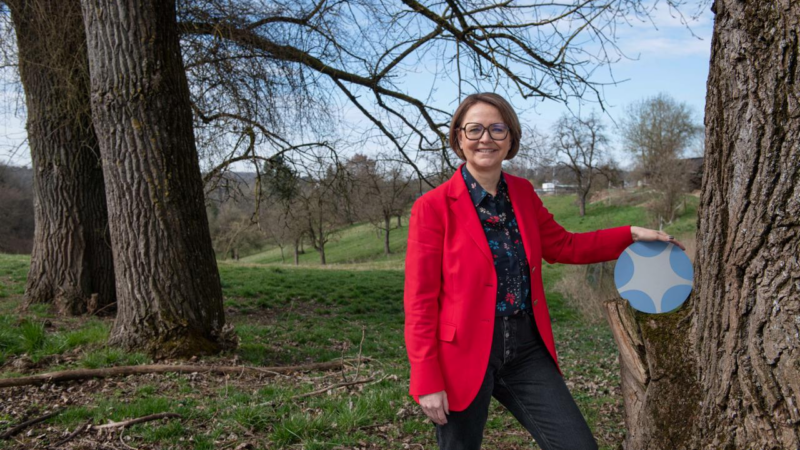Two new techniques boost heat treatment flexibility in press hardening structural parts made of 22MnB5
At the Thermprocess trade fair, Schwartz will be premiering two innovations developed in-house for the press hardening of sheet metal: tailored tempering with a „thermal printer“ produces different hardness zones in the part, while a dew point control system for the air atmosphere of roller-hearth furnaces reduces the risk of oxygen-induced embrittlement.
Tailored tempering
The new „thermal printer“ enables the user to create multiple regions of different hardness in the same sheet metal blank. A targeted, localized heat treatment exposes the part to a locally varying time/temperature curve. Thus, in addition to the hard martensitic areas obtained by conventional press hardening, it is possible to produce soft zones with a microstructure comprising ferrite, pearlite and bainite.
By this accurately focused heat treatment, Schwarz achieves a very narrow hardness transition area in the product. The thermal printer can provide a 250 °C temperature differential over a width of only 60 mm. On a tailored tempered blank subjected to a 550 °C holding temperature, hardness measurements in the soft zone revealed a bainitic microstructure having a hardness of 350 HV. The area of transition to the hard zone was only 30 mm wide.
The printer is integrated into a press-hardening line in the furnace-to-press transfer section. In a dual configuration using two printers, cycle times of around 20 seconds can be achieved with this process.
Schwartz uses a mathematical model based on finite-difference modeling to model the temperature pattern across the blank, from which the parameters for temperature distribution in the printer are then derived.
Dew point control
At Thermprocess, Schwartz will also present their three-zone dew point control system for roller-hearth furnaces for the first time. The technology manages the dew point in three separate, individually controlled zones via the supply of very dry air.
This development was driven by the observation that in aluminium-silicon (AlSi) coated parts, cracks due to hydrogen embrittlement may occur in the base material after the press hardening process. Accordingly, even loads below the material’s limit of elasticity may result in its fracture. The phenomenon is likely to be caused by sub-dew point conditions during heat treatment.
With the new dew point control system, the dew point inside the roller hearth furnace can be precisely controlled and brought down to as low as -20 °C. One central element of this system is an automatically self-„tuning“ laser measuring cell developed specifically for this application case. Unlike capacitive systems, it delivers precise results in a few seconds‘ time.
For the measurement the laser light is reflected by a mirror. Since the system evaluates the diffuse reflection, it provides precise measurements even when the mirror is dirty, in contrast to conventional sensors. A window is the only optical component with exposure to the sample chamber. This design makes for a reliable and maintenance-friendly measurement.
Schwartz at Thermprocess 2015 (Düsseldorf, 16 – 20 June):
Hall 09, Stand F42
About Schwartz
Schwartz develops and manufactures high-efficiency heat treatment systems for annealing, hardening, forging, sintering and tempering ferrous and nonferrous metals. In each of these processes, the heat treatment can be carried out under air, protective gas and/or reactive atmospheres.
Especially for the heat treatment of aluminium, Schwartz designs and builds equipment based on high-convection heating, e.g. by the jet heating method.
Over the decades, Schwartz GmbH has come into the spotlight time and again for its innovative systems. One example is the technology of press-hardening sheet metal, which was pioneered by Schwartz along with the associated environmental protection solutions. At one German automotive manufacturer, equipment supplied ex Simmerath saves huge amounts of CO2 each year – the cuts are equivalent to the emissions of a small city with a population of 32,000.
At the Simmerath headquarters site, around 3,000 sq.m. of floorspace are dedicated to the manufacture, assembly and commissioning of heat treatment equipment. There are currently 110 people employed at the Simmerath factory; the company has a total workforce of 150 employees worldwide.
In 2011, the manufacturing subsidiary Schwartz Heat Treatment Systems Asia (Kunshan) Co. Ltd. was founded in Shanghai, PR China. Another subsidiary, Schwartz Inc. of Oswego, Illinois (U.S.A.), has been active since 2012. Now as before, all equipment is fully erected, heated up before shipment, and subjected to pre-commissioning at the production facility (Simmerath and Kunshan).
Firmenkontakt
Schwartz GmbH
Elke Müller
Edisonstraße 5
52152 Simmerath / Germany
+49.2473.9488-0
+49.2473.9488-11
info@schwartz-wba.de
www.schwartz-wba.de
Pressekontakt
VIP-Kommunikation
Regina Reinhardt
Süsterfeldstraße 83
52072 Aachen / Germany
+49.241.89468-24
+49.241.89468-44
reinhardt@vip-kommunikation.de
www.vip-kommunikation.de






